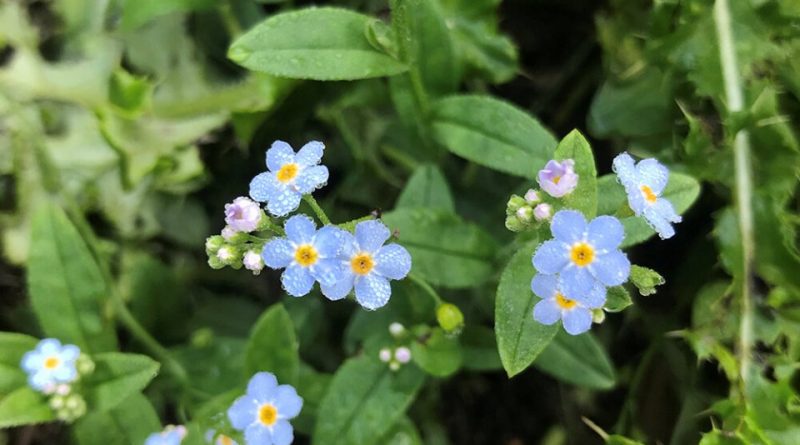Myosotis scorpioides
Myosotis scorpioides
The Water Forget-Me-Not (Myosotis scorpioides L.) is a perennial herbaceous species belonging to the Boraginaceae family.
Systematics –
From a systematic point of view it belongs to:
Eukaryota Domain,
Kingdom Plantae,
Magnoliophyta Division,
Magnoliopsida class,
Subclass Asteridae,
Lamiales Order,
Boraginaceae family,
Genus Myosotis,
M. scorpioides species.
The terms are synonymous:
– Myosotis laxiflora Rchb .;
– Myosotis multiflora Mérat;
– Myosotis palustris (L.) Hill;
– Myosotis palustris subsp. laxiflora (Rchb.) M.Sychowa;
– Myosotis palustris subsp. multiflora (Mérat) Rouy;
– Myosotis scorpiodes subsp. multiflora (Mérat) P.Fourn .;
– Myosotis scorpioides subsp. palustris (L.) F. Herm .;
– Myosotis scorpioides var. palustris L .;
– Myosotis palustris Hill, nom. illeg ..
Etymology –
The term Myosotis comes from the Greek μῦς, μυός mys myós mouse and from οὖς, ωτόϛ oús, otós ear: mouse ear.
The specific epithet scorpioides comes from the Greek σκορπίος scorpíos scorpio and from εἶδος eídos appearance, appearance: due to the arched inflorescence like the tail of a scorpion.
Geographic Distribution and Habitat –
Myosotis scorpioides is a plant native to Europe, present as far north as Great Britain and Scandinavia and south as far as northern Africa, and Asia, but is widely distributed elsewhere, including much of North America, as an introduced species and sometimes as an invasive plant.
In Italy it is present in almost all regions of mainland Italy (it is absent in Puglia and Calabria and has not yet been reported for Emilia-Romagna).
Its habitat is that of humid or wet environments, such as swamps, ponds, streams, ditches, swamps and rivers. Although it prefers moist soil, it can survive submerged in water and can often form floating rafts. Its altimetric distribution goes from sea level to about 2000 m.
Description –
Myosotis scorpioides is a biennial or perennial herbaceous plant with rhizomes and creeping stolons and with a stem up to 1 m high.
The leaves are oblong to oblong-lanceolate and pubescent on both sides.
The flowers are pink in bud which then turn pale blue when fully open, 4-8 mm in diameter with yellow centers and honey-white guides.
It blooms from mid-spring to the first frosts in temperate climates.
The fruit is a microbasarium (tetranucula) with 4 monospermic mericarps (nucule), ovatii, edged at the top, smooth, blackish, measuring 1.2-1.8 mm.
Cultivation –
Myosotis scorpioides is an evergreen perennial that is harvested in nature for local use as a medicine.
It can be grown in moist and sunny soil but also grows in places bordering humid areas and in shady places. It grows well in heavy clay soils.
Plants are hardy to around -20 ° C.
The plant spreads freely when growing in swampy soils.
Propagation can take place by seed, directly in situ in late spring or early summer. Germination usually takes place within 2 – 4 weeks at 20 ° C.
It can also multiply by division in spring.
Furthermore, cuttings of young shoots can be prepared, in the summer period to be planted in shady areas.
Customs and Traditions –
The Water Forget-Me-Not is a plant that was once harvested in the wild and used for some medicinal purposes.
Among these it is certain that it was used in the treatment of whooping cough and bronchitis.
The active ingredients are mainly contained in the flowers and are: mineral salts, in particular potassium salts, organic acids of various kinds and sugars.
It is well known and appreciated not only for the delicacy of its flowers, but also for its medicinal properties once much exploited by natural medicine and phytotherapy.
However, other uses of this plant are not known.
The plant does not have a toxic action on the body but, as always, it is recommended not to exceed the indicated doses in order to avoid unpleasant side effects.
Preparation Method –
Of Myosotis scorpioides, both the flowers and the whole plant are harvested for preparations aimed at respiratory diseases such as whooping cough and bronchitis.
Guido Bissanti
Sources
– Acta Plantarum – Flora of the Italian Regions.
– Wikipedia, the free encyclopedia.
– Useful Tropical Plants Database.
– Conti F., Abbate G., Alessandrini A., Blasi C. (ed.), 2005. An annotated checklist of the Italian vascular flora, Palombi Editore.
– Pignatti S., 1982. Flora of Italy, Edagricole, Bologna.
– Treben M., 2000. Health from the Lord’s Pharmacy, Advice and experiences with medicinal herbs, Ennsthaler Editore.
Warning: Pharmaceutical applications and alimurgical uses are indicated for informational purposes only, they do not represent in any way a medical prescription; therefore no responsibility is taken for their use for curative, aesthetic or food purposes.


